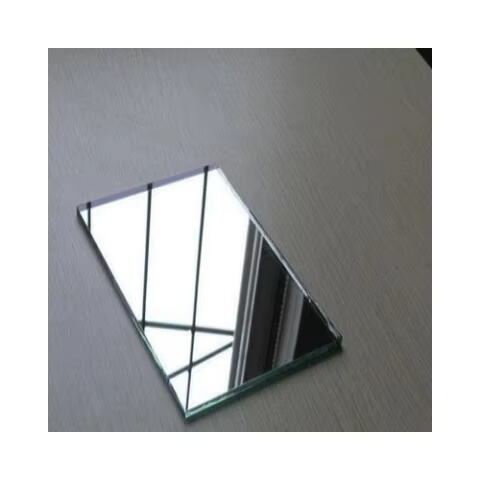Creating Visual Depth with Decorative Glass
Adding decorative glass to interior design really opens up small spaces, making them feel bigger than they actually are. What makes this work is how the glass plays with light, letting it pass through and bounce around in ways that fool our eyes about the actual size of the room. When trying to get this effect right, different kinds of glass finishes matter a lot. Take translucent glass for starters it softens the light instead of letting it blast straight through. Colored glass does something completely different though, bringing color and energy into whatever space it's installed in. There are so many choices out there that designers have plenty of room to experiment with perceptions. Some folks even install colored glass walls between areas, which creates interesting visual effects without closing off the space entirely.
Interior designers are finding all sorts of ways to make small spaces feel bigger these days, and there's actually some science behind it. Experts who study how people interact with their environments claim that decorative glass really works wonders for creating the illusion of more space. A recent article in the Journal of Interior Design mentioned something interesting about this topic. They found that when homeowners install glass partitions or wall panels throughout their homes, rooms tend to look about 30 percent larger than they actually are. Pretty impressive stuff if you ask me! The beauty of decorative glass lies in its ability to trick our eyes into thinking there's more room than there really is, which makes even cramped apartments feel welcoming and open.
Reflection Techniques to Amplify Light
Decorative glass with reflective properties works wonders for brightening interiors by cleverly redirecting both sunlight and artificial lighting throughout a space. The effect creates a much brighter environment overall, which makes rooms appear larger and more inviting than they actually are. When designers incorporate items like mirrors, those fancy iridescent panels, or that special low-emissivity glass, they get double benefits from the materials. Light bounces around better, sure, but these surfaces also help cut down on electricity bills because less supplemental lighting is needed. According to research from the Lighting Research Center, some real world examples show that buildings using reflective glass have seen their lighting expenses drop by as much as twenty percent while still maintaining great visual comfort levels.
Glass plays several roles in interior design work. Mirrors really help brighten up those dark spots in rooms where natural light doesn't reach well. Low-e glass does something different but just as important it keeps heat from moving through windows, which actually helps buildings save on energy costs over time. Interior designers working with architects and experienced contractors have started using these reflective materials in all sorts of places lately. Some commercial offices now look completely transformed after adding mirrored surfaces along walls and ceilings. Designers aiming for spaces that feel lively without costing the earth on utilities find this approach works wonders. Most projects end up looking beautiful while still meeting green building standards, though getting the proportions right takes some trial and error during planning stages.
Elevating Aesthetics Through Textured Glass Designs
Frosted Glass for Subtle Sophistication
Frosted glass brings a certain class to spaces because it acts like a wall between views while still letting light pass through. People put this kind of glass in offices and bathrooms all the time since it keeps things private but doesn't close off the area completely. What makes frosted glass so great is how adaptable it really is. There are different looks available too, like when they blast sand on it or etch it with acid. Each finish gives homes and businesses their own special character. Interior designers love working with frosted glass because it has that modern feel without being too flashy. It just fits right in with most decor styles these days. Most folks who know about design will tell anyone that what makes frosted glass stand out is how it adds dimension to rooms without taking over the whole space.
Etched Patterns as Artistic Statements
Glass etching turns plain surfaces into works of art, adding all sorts of interesting designs and patterns that really make spaces stand out. People are getting more interested in custom etched glass lately, especially those looking for designs inspired by nature or cool geometric shapes. The benefits go beyond just looking good too. Homes with these special glass features actually sell better in the market according to many realtors who've seen this firsthand. Interior designers love working with etched glass because it serves double duty as something beautiful while also boosting a home's overall value when it comes time to put it on the market.

Maximizing Natural Light in Modern Interiors
Glass Partitions to Optimize Daylight
Glass walls are great for letting in lots of natural light in homes and offices alike. Light flows right through them instead of bouncing off solid walls, making spaces feel much more open and pleasant. People generally look better too when there's good lighting around. Some research out of Harvard actually points to something interesting about this whole thing. Their findings suggest workers in brighter environments tend to be 5 to maybe even 15 percent more productive than those stuck under boring fluorescent lights all day long.
When working with glass partitions, there are some important things to think about when it comes to sound control and keeping private spaces private. After all, nobody wants their conversations echoing across the room just because they opted for see-through walls. The good news is that there are ways to get both privacy and that open feel glass offers. Many designers use special sound dampening methods combined with frosted or patterned glass panels. Take a look around at contemporary spaces these days and chances are pretty good you'll spot those sleek frameless glass separators common in Nordic-style workplaces and residences. They manage to keep noise levels down while still letting light flow through, making them popular choices despite what some might assume about glass being too revealing.
Skylights and Glass Ceiling Innovations
Adding skylights and glass ceilings really transforms how a room feels because they let so much natural light inside, which cuts down on our need for electric lights during the day. People often forget just how impactful good daylighting can be until they see it firsthand. The numbers back this up too. A research group called the National Energy Foundation looked into this stuff and found that properly placed skylights could slash lighting costs by around 40%. That's pretty impressive when we think about all the money saved over time, not to mention the environmental benefits from reduced electricity usage.
New developments in glass tech have brought better heat control and much better protection against UV rays, so glass ceilings are becoming both beautiful to look at and good for saving energy. Take the Apple Store on Fifth Ave in NYC as a great example their famous glass cube lets in lots of daylight without causing too much glare or letting in excessive heat. For homes, people are starting to install things like round skylights or big open ceilings that flood rooms with natural light. These features don't just brighten up a space they actually change how we experience our living areas completely.
By emphasizing the utility of glass partitions, skylights, and glass ceilings, we capture a dual benefit: aesthetic improvement and enhanced natural lighting. These installations not only contribute to energy efficiency but also elevate the design and functionality of any modern interior.
Sustainable Style: Eco-Friendly Glass Solutions
Recycled Decorative Glass Applications
When people choose recycled decorative glass, they get two good things going on at once: helping protect the environment while also adding something beautiful to their space. Glass that gets recycled can become really nice looking stuff like tiles, countertops, and even wall panels. For folks who care about living sustainably, these options are pretty great. Not only do they cut down on waste, but they actually help reduce the overall harm to our planet. The numbers back this up too. Recycling just one ton of glass saves more than a ton worth of raw materials that would otherwise need mining or processing. And let's face it, more people are starting to prefer green materials these days. A recent survey found that around 61 percent of shoppers are ready to spend extra bucks on sustainable products. This shift towards eco-conscious choices shows up all over home design trends right now.
Energy-Efficient Insulated Glass Designs
Insulated glass makes a big difference when it comes to making buildings more energy efficient while also improving comfort levels and cutting down on expenses. The main idea behind these units is simple really they stop too much heat from moving through the window, so homes stay cooler during hot summers and warmer when winter rolls around. Glass tech has come a long way lately, and research shows that switching to insulated glass can cut energy bills anywhere from 20 to 30 percent depending on where someone lives. Take double glazed windows for example the space between two panes of glass acts like an extra barrier against temperature changes. We've seen this work well in commercial buildings especially office spaces where maintaining consistent temperatures matters a lot. Although the upfront price might seem steep at first glance, most property owners find that their monthly utility costs drop enough over time to make the investment worthwhile.
Practical Elegance: Durability Meets Design
Easy Maintenance for Busy Households
Decorative glass stands out because it doesn't take much work to keep looking good, which makes sense for people who have hectic schedules at home. Glass surfaces generally clean up pretty easily, plus there are all sorts of treatments available these days that make them last longer and fight off those annoying smudges. Take nano coatings for instance they actually push away dirt and water spots so the glass stays nice and clear without needing constant scrubbing. Most folks just grab some gentle soap mixed with water and wipe things down occasionally, steering clear of anything too harsh on the surface. Many homeowners find that adding glass elements like backsplashes or countertops gives their space both style points and real world benefits. Beyond just making kitchens look better, this kind of glass helps cut down on cleaning time, meaning families get to spend more quality moments together instead of wrestling with stubborn stains.
Decorative glass needs some care to stay looking good over time. Dust regularly with a microfiber cloth rather than paper towels which might leave lint behind. Tiny particles build up fast and scratch delicate surfaces without anyone noticing until it's too late. Stay away from harsh chemical cleaners on anything with fancy detailing or special etching work. Those fancy patterns are what make glass pieces stand out but also what gets damaged easily. When things get really dirty, mix equal parts white vinegar and warm water in a spray bottle. Let it sit for a few minutes before wiping down stubborn spots. A little elbow grease goes a long way here. These simple steps help maintain that elegant look while dealing with everyday messes around the house. After all, nobody wants their favorite stained glass window turning into something dull just because nobody thought to give it proper attention once in a while.
Scratch-Resistant Treatments
Glass treatments that resist scratches work wonders for keeping decorative glass looking good, particularly in places where people walk through all day long. These protective coatings not only make glass last longer but also keep it looking clean and attractive, which explains why they show up everywhere from home kitchens to office buildings. Manufacturers use some pretty sophisticated tech to create these coatings so they can handle daily bumps and abrasions without losing their shine. As more businesses and homeowners deal with the frustration of scratched glass surfaces, demand for these protective treatments keeps rising across the construction and interior design industries.
When it comes to how well they hold up over time, research shows treated glass beats regular glass hands down for lasting power. People who buy it tend to be pretty happy because there's not much upkeep needed and it just keeps looking good year after year. Take businesses for example many store owners love installing scratch resistant glass in their display areas since it stays looking sharp even when customers constantly touch and look at products. The stuff lasts forever basically. Adding this kind of treatment to decorative glass means the initial cost gets justified through long term value while keeping spaces looking attractive whether at home or in office settings.
FAQ
What types of decorative glass can enhance the sense of openness in a room?
Translucent glass and colored glass are effective options for enhancing openness, as they allow light to diffuse gently while adding vibrancy.
How can reflective surfaces in decorative glass amplify light in an interior space?
Reflective surfaces like mirrors and iridescent glass skilfully bounce natural and artificial light, contributing to a luminous and welcoming atmosphere.
What are some advantages of frosted glass in interior design?
Frosted glass provides privacy while acting as a light diffuser, offering a subtler aesthetic that blends well with contemporary interiors.
How does using recycled decorative glass contribute to sustainability?
Recycled glass reduces waste and environmental impact and can be transformed into decorative tiles and countertops, appealing to eco-conscious consumers.
What benefits do insulated glass designs offer in terms of energy efficiency?
Insulated glass minimizes heat transfer, aiding thermal regulation in buildings and potentially reducing energy costs by up to 30%.
Table of Contents
- Creating Visual Depth with Decorative Glass
- Reflection Techniques to Amplify Light
- Elevating Aesthetics Through Textured Glass Designs
- Maximizing Natural Light in Modern Interiors
- Sustainable Style: Eco-Friendly Glass Solutions
- Practical Elegance: Durability Meets Design
-
FAQ
- What types of decorative glass can enhance the sense of openness in a room?
- How can reflective surfaces in decorative glass amplify light in an interior space?
- What are some advantages of frosted glass in interior design?
- How does using recycled decorative glass contribute to sustainability?
- What benefits do insulated glass designs offer in terms of energy efficiency?


